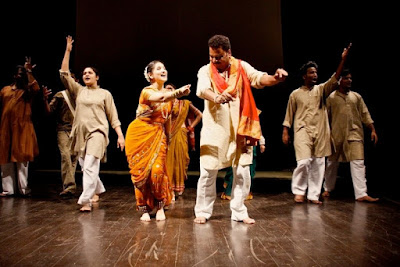Background
of Tamasha
Tamasha
is traditionally a form of Marathi theatre which involves singing and dancing.
It is performed by local people of Maharashtra as well as the travelling theatre
groups. It came into existence in the 16th century of Maharashtra.
The word Tamasha,
is originally Persian. In Indian official languages like Hindi, Urdu, Marathi-
the word Tamasha denotes fun or play. More precisely, the word connotes something which is
hilarious. Many times the word is used to identify some act as irritating or
not desirable. More or less, the word for sure, means some excitement and
cheer. The theatre greatly combines play with song and dance.
 |
| Picture courtesy: google image/wikipedia |
Traditionally, Tamasha
is influenced by many Indian art forms which include kaveli, ghazals, kirtan, dashavatara
and very popular dance form, Kathak. Though it came into existence in the 16th
century but the theatre form took the bigger and prominent shape only in 18th
century. With the development of textile industry in 19th century in
Bombay(now Mumbai), workers from rural side shifted to the city carrying the theatre
form with them. Thus a complete move of the theatre called Tamasha took place only then. In the early years of textile
industry in Bombay, Tamasha
performers were invited to showcase the art form but it is later the art form
flourished as more and more people joined the theatre group and learned the art
form. In the beginning, the so-called low castes of Indian castes system used
to perform Tamasha which includes
Kolhati, Mahar, Mang and Bhatu from outskirts of Maharashtra. After
Independence, however, the urban middle class turned away from traditional art
forms creating a distinction between urban and rural audience, as Tamasha continued to sweep the urban
audience.
No comments:
Post a Comment